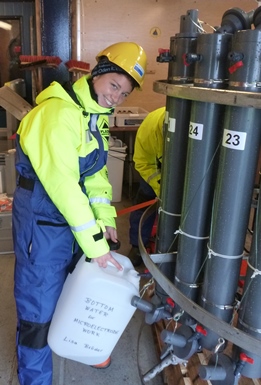LISA 20140708 0900 UTC
|
Enough about parties and miserable weather, we are here to do SCIENCE! So I’ll try to put this into a bit of a perspective, since we do spend most of the day thinking about the sampling and experiments we are about to do. Yesterday, for instance, we had a very long, productive meeting. My teammates are Joanna Sawicka, Volker Brüchert and Vladimir Samarkin, who are mainly interested in microbiological Processes that take place in the water and sediment. They will measure concentrations (how much is there?) and fluxes (how much does it change?) of many different substances both in the sea water and in the sediments and even in the water that is between the sediment grains, the so-called pore water. In our meeting we decided on a sampling plan for each of our experiments and distributed the various tasks. Everything of course needs to be coordinated between the different groups: I will work with sediment cores that need to be collected but will also need water from the bottom of the sea for the small aquarium in which I will conduct my measurements because we want to keep the sediment samples in an environment that is similar to the one they come from. We of course need to prioritize: some analyses have to be done quickly; others can wait a bit longer. For example people interested in gases have to go first to get their samples, the substance they want to measure might otherwise already have disappeared from their sample. Fortunately, timing for my measurements is not so critical. Well stored, I can keep my sediment cores for several hours before starting the analyses. This may become important, because we have not tested my whole setup on an icebreaker yet.
Our area of interest is the outer part of the East Siberian Shelf (shelf means very shallow waters, mainly less than 100m water depth) and the slope where water depths rapidly increase up to 3000m(!!). One of the questions we want to find answers to is the transport of sediment on and off the shelf, therefore we will start off with taking a lot of samples along a transect (transect = basically a fancy word for a straight line), coming from the deep waters going up the slope to the shelf. We expect to arrive at our first station in four days from now. By then everything and everyone needs to be ready, well prepared and rested – then it will get intense...
|
| by Lisa Bröder |

 I aim to measure how oxygen concentrations change with
I aim to measure how oxygen concentrations change with 












